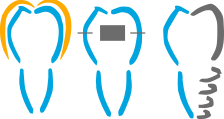Periodontological interventions
Periodontology is a specialty which deals with the disorders of the supporting tissues of teeth and which underwent a revolutionary development in the last two decades. Regular control is essential during the treatments of patients who suffer from pyorrhoea, since this illness can only be kept in a good condition by daily oral hygiene and regular professional dental hygienic treatment. We always prefrom cleaning treatments during controls. Pockets around the teeth, that are filled with causative agents, are the most aggressive ones.

The major types of periodontal disease
- gingivitis with mild gum bleeding which is reversible without causing permanent damage
- the so called aggressive periodontal disease among young people (in their 30s) which appears either on certain teeth or all of the teeth
- slowly evolving chronic periodontal disease that rather appears in the old age
- different types of suddenly evolving periodontal diseases such as the acute gum inflammation, gingival abscess, or the ulcerative gingivitis
- periodontal diseases that can occur together with other general diseases like leukaemia, diabetes or hormonal changes (during pregnancy)
- other diseases that primarily cause aesthetic problems and sensitive tooth neck such as the gum recession
Symptoms of periodontal disease
- bleeding gums
- sensitivity, pain
- swelling
- moving teeth
- tooth migration (due to shifting teeth gaps appear between them)
- food impaction
- sensitivity of tooth neck (to cold or hot)
When does it occur?
What is dangerous about periodontal diseases is that often they do not cause any problems for the patients, however, they do exist and patients only realize this when they are in an advanced stage.
They can occur among young and elderly people as well, however as it takes a long time to evolve, they mostly appear among people over 40 or 50.
Is it possible to treat
The treatment is divided to more stages. When the problem is only confined to the gums, the process is completely reversible. However, if the disease spreads onto the bone, the damage can be stopped, however, it cannot be reversed in every case. This is why prevention and regular control is of high importance in order to start the appropriate treatment in time.
Treatments
Oral hygiene instruction and motivation in order to make the treatment efficient and the result long-lasting, the cooperation of the patients is essential. That is why we provide help with the acquirement of proper oral hygiene and during check-ups we make sure this endures.

Scaling /tartar removal: Tartar cannot be removed by methods used at home. This must be done in the surgery with special manual instruments and an ultrasonic device.


Exchange of old and badly fitted prosthesis, in order to stop the so called plaque retentive factors periodontal problems are more likely to appear both at fillings and at fixed and removable prostheses (crowns, bridges). The reason for this is that these places are difficult to clean, and if the tooth is not prepared properly, it is impossible to make such a prosthesis that fits well and does not emerge from the plane of the tooth. Unfortunately, a badly fitted prosthesis can maintain the inflammation thus the treatment of the periodontal problem is in vain. In these cases the exchange of the replacement is advised, however, it is only effective if the teeth are prepared by the so called shoulder preparation, or – if it is not possible – we do not present the dental work under the gum.

Treatment of closed curettage: The so called periodontal pockets (which maintain the inflammation) around the tooth are cleaned under local anesthesia by manual instruments. For this intervention a laser device which improves the efficiency of the treatment is also available in our surgery.


Open curettage: This is one of the periodontal surgical interventions. After making incisions on the gums under local anesthesia, the periodontal pockets are cleaned with a direct view. Then the gums are laid back with the help of stitches. The stitches will be removed after 10 to 14 days.
Splinting The fixation of moving teeth to each other with the purpose of helping the healing process (temporary splints) or stopping the further migration of teeth (permanent splints). This also includes the retainers used after orthodontics which stop teeth from moving back when the treatments are over.





Regenerative interventions periodontal surgical intervention which aims at restoring a condition identical with the original one (new bone, periodontal fibre, root cementum). There are several possibilities today, including different bone replacement materials, membranes and such materials that start regenerative procedures of the organism so that it can produce new tissues itself (Emdogain).




The selection of the appropriate technique depends on the shape, size, place, and number of vertical bone loss.
Periodontal plastic surgery: primarily aesthetic gum corrections which can correct gingival recessions or enlargements through operation. It is also performed under local anaesthetics.




